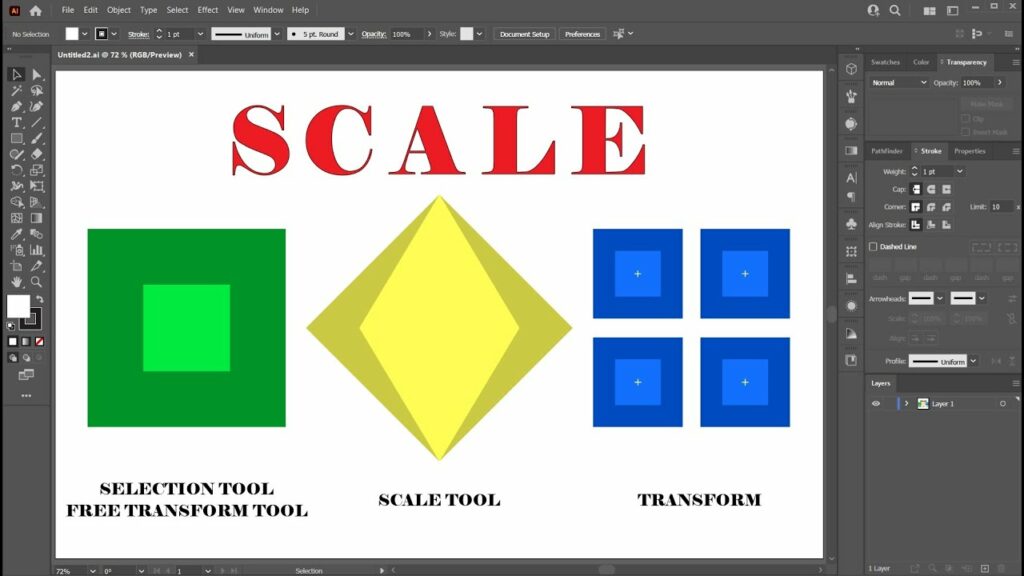Mastering Scaling: A Comprehensive Guide to Using the Scale Tool in Adobe Illustrator

Introduction: Scaling is a fundamental aspect of graphic design, allowing designers to resize and transform objects while maintaining proportion and quality. In Adobe Illustrator, the Scale Tool is a powerful feature that provides precise control over the size and dimensions of objects, shapes, and artwork. In this extensive guide, we’ll explore the intricacies of using the Scale Tool in Adobe Illustrator, covering its functionalities, techniques, and creative applications.
Part 1: Understanding the Scale Tool
- Introduction to Scaling: The Scale Tool in Adobe Illustrator enables users to resize selected objects, shapes, or artwork while preserving their proportions. It allows for uniform scaling, non-uniform scaling, and scaling based on specific dimensions or percentages.
- Accessing the Scale Tool: The Scale Tool can be accessed from the Tools panel in Adobe Illustrator, or by pressing the “S” key on the keyboard. Once activated, the cursor changes to a double-headed arrow icon, indicating that you’re ready to scale objects.
Part 2: Basic Techniques for Using the Scale Tool
- Scaling Objects Proportionally: To scale an object proportionally using the Scale Tool, select the object(s) you want to scale and then click and drag one of the corner handles of the bounding box. Hold down the Shift key to constrain proportions and maintain the object’s aspect ratio.
- Scaling Non-Proportionally: For non-uniform scaling, where the object’s width and height are scaled independently, click and drag one of the side handles of the bounding box without holding down the Shift key. This allows for stretching or squashing the object along one axis.
- Scaling from a Specific Point: To scale an object from a specific point or center, hold down the Alt (Option) key while dragging one of the corner or side handles of the bounding box. This allows for precise control over the scaling pivot and placement.
Part 3: Advanced Techniques and Tips
- Scaling Based on Specific Dimensions: Users can specify precise dimensions for scaling objects using the Scale dialog box. Pressing the Enter key after entering the desired width and height will scale the selected object(s) to those dimensions.
- Using Reference Points: Illustrator provides reference points that allow users to scale objects relative to specific anchor points or centers. Choose a reference point from the Reference Point Locator in the Control panel to control the scaling behavior.
- Scaling Strokes and Effects: When scaling objects with strokes or effects applied, users can choose to scale strokes and effects proportionally or independently. Enable or disable the “Scale Strokes & Effects” option in the Transform panel or Scale dialog box as needed.
Part 4: Creative Applications of the Scale Tool
- Resizing Artwork: The Scale Tool is commonly used to resize entire artwork or compositions while maintaining proportion and visual balance. Use it to adjust the size of illustrations, logos, or graphics for different applications or media.
- Creating Visual Effects: Experiment with scaling to create visual effects such as perspective distortion, foreshortening, or exaggerated proportions. Use non-uniform scaling to distort objects for creative and artistic purposes.
- Designing Layouts and Templates: Use the Scale Tool to create layouts and templates with resizable elements. Design templates for posters, flyers, or web layouts with scalable components that can adapt to different sizes and dimensions.
Conclusion
The Scale Tool in Adobe Illustrator is a versatile and indispensable feature that offers endless creative possibilities for designers and artists. By mastering the techniques and tips outlined in this guide, you’ll be able to wield the Scale Tool with precision and efficiency, unlocking a world of design opportunities. Whether you’re resizing objects, creating visual effects, or designing scalable layouts, the Scale Tool is your trusted companion for achieving perfect proportions and transformations in Adobe Illustrator. So, dive in, experiment fearlessly, and let your creativity scale new heights!




